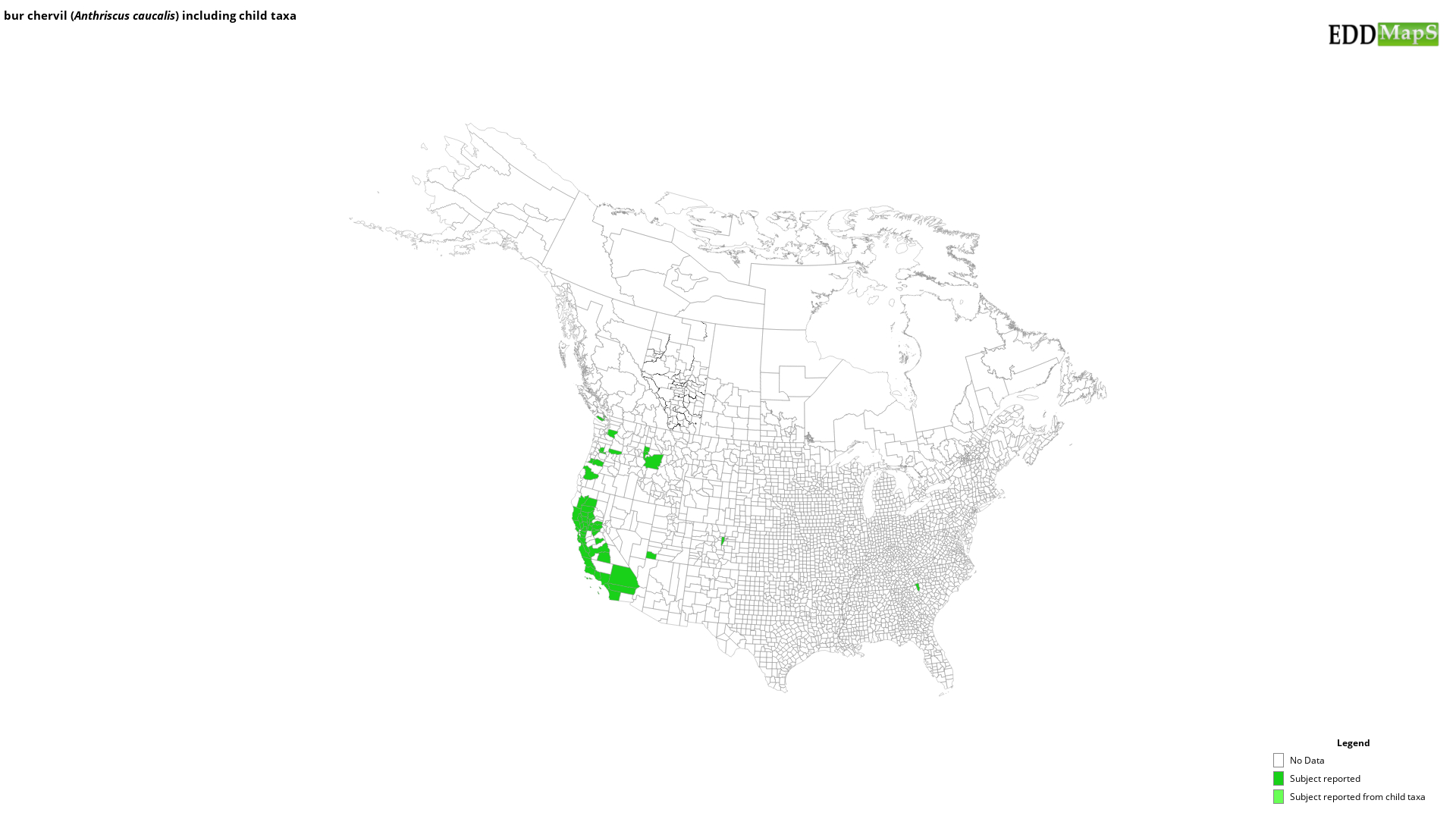bur chervil
(Anthriscus caucalis)
This species is Introduced in the United States
ORIGIN: Eurasia
GROWTH TRAITS: Anthriscus caucalis is an herbaceous, taprooted, and generally less than 3’ tall (0.9 m) but may reach 6’ (1.8 m) on occasion. Stems are hollow and branching with alternate leaves that are 2-3 times divided, appearing fern-like. Leaves are larger at the plant base, have short, stiff hairs, and are gradually reduced in size upwards on the plant stem. Flowers are white and have 5 petals. A. caucalis is an annual species that typically germinate in fall. Flowers are arranged in compound umbels at leaf axils and bloom in spring. Fruits are <¼” long (6 mm), beaked, and covered with hooked hairs
REPRODUCTION: Spreads only by seed. Seed viability is unknown.
HABITAT: Bur chervil is found in moist and disturbed areas along ditch banks and in meadows, open forests, and irrigated pastures.
LOOK-ALIKES: The combination of hollow stems, fern-like leaves, and 5-petaled white flowers arising from umbels help differentiate these species from many non-Apiaceae look-alikes. Examining the fruits can help differentiate species in the Apiaceae family. Bur chervil resembles the related poison hemlock (Conium maculatum), a deadly species invasive in North America. Poison hemlock can grow much taller (10’ or 3 m) and has larger stems overall covered in small, purple spots. The umbel location (leaf axils rather than stem tips) and hair on fruits help differentiate bur chervil from wild chervil.
CITATIONS:
Winston, R.L., Andreas, J.E., Milan, J., DesCamp, W., Randell, C.B., and M. Schwarzländer. 2014. New Invaders of the Northwest. United States Department of Agriculture, Forest Health Technology Enterprise Team. FHTET-2014-12. Retrieved from https://www.fs.fed.us/foresthealth/technology/pdfs/FHTET-2014-12_NW_New_Invaders.pdf
GROWTH TRAITS: Anthriscus caucalis is an herbaceous, taprooted, and generally less than 3’ tall (0.9 m) but may reach 6’ (1.8 m) on occasion. Stems are hollow and branching with alternate leaves that are 2-3 times divided, appearing fern-like. Leaves are larger at the plant base, have short, stiff hairs, and are gradually reduced in size upwards on the plant stem. Flowers are white and have 5 petals. A. caucalis is an annual species that typically germinate in fall. Flowers are arranged in compound umbels at leaf axils and bloom in spring. Fruits are <¼” long (6 mm), beaked, and covered with hooked hairs
REPRODUCTION: Spreads only by seed. Seed viability is unknown.
HABITAT: Bur chervil is found in moist and disturbed areas along ditch banks and in meadows, open forests, and irrigated pastures.
LOOK-ALIKES: The combination of hollow stems, fern-like leaves, and 5-petaled white flowers arising from umbels help differentiate these species from many non-Apiaceae look-alikes. Examining the fruits can help differentiate species in the Apiaceae family. Bur chervil resembles the related poison hemlock (Conium maculatum), a deadly species invasive in North America. Poison hemlock can grow much taller (10’ or 3 m) and has larger stems overall covered in small, purple spots. The umbel location (leaf axils rather than stem tips) and hair on fruits help differentiate bur chervil from wild chervil.
CITATIONS:
Winston, R.L., Andreas, J.E., Milan, J., DesCamp, W., Randell, C.B., and M. Schwarzländer. 2014. New Invaders of the Northwest. United States Department of Agriculture, Forest Health Technology Enterprise Team. FHTET-2014-12. Retrieved from https://www.fs.fed.us/foresthealth/technology/pdfs/FHTET-2014-12_NW_New_Invaders.pdf
Selected Images
Maps
EDDMapS Distribution - This map is incomplete and is based only on current site and county level reports made by experts, herbaria, and literature. For more information, visit www.eddmaps.org
State Lists - This map identifies those states that have this species on their invasive species list or law.
Taxonomic Rank
| Domain: Eukarya |
| Kingdom: Plantae |
| Phylum: Magnoliophyta |
| Class: Magnoliopsida |
| Superorder: Asteranae |
| Order: Apiales |
| Family: Apiaceae |
| Genus: Anthriscus |
| Anthriscus caucalis |
References
Common Name Reference: USDA, NRCS. 2010. The PLANTS Database. National Plant Data Center, Baton Rouge, LA, USA.
Scientific Name Reference: USDA, NRCS. 2010. The PLANTS Database. National Plant Data Center, Baton Rouge, LA, USA.


